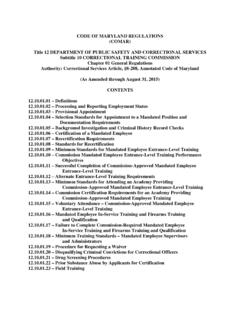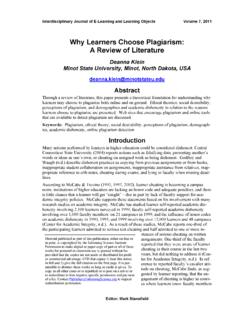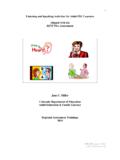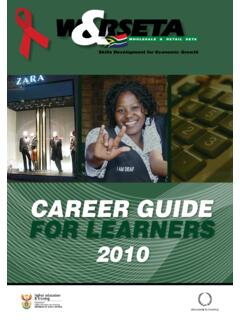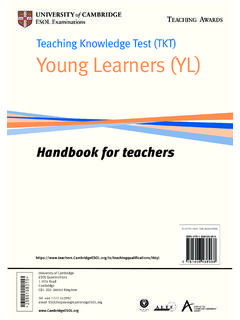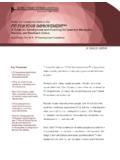Transcription of A Tsunami of Learners Called Generation Z - MDLE.net
1 A Tsunami of Learners Called Generation Z by Darla Rothman, Abstract: As we look ahead to the year 2020, we recognize the necessity of preparing for a new Generation of workers. This fifth Generation , known as Generation Z, Gen Z, Digital Natives, or Generation 2020 (the year that they graduate from college), will have a major impact on the workplace. This is the first Generation born into an Internet-connected world. Because their use of technology has developed the visual ability portion of their brains, visual forms of learning are more effective for these Learners . Furthermore, the use of fast-paced multimedia has affected the ability of these Learners to focus and analyze complex information. Also, technology use has had a significant impact on attention span. With online text, Learners now spend about eight seconds picking hyperlinked keywords to find answers instead of reading the whole text, which calculates to seconds per 100 words of text.
2 Instructors teaching in 2020 must be prepared to teach using software, hardware, and digital, technological and social media. Some instructors will need professional development support to help them move from a traditional to a transformational learning model. It is now 2014; will we be ready to teach Generation Z in 2020? Keywords: Generation Z Gen Z Generation 2020 Digital natives Learning Style You are probably asking yourself who the heck is Generation Z (Gen Z) and why do I need to know about them? I m sure you have heard of Veterans (1925-1944), Baby Boomers (1945-1964), Generation X (1965-1980) and Generation Y (1981-1995) now in the workplace. Let me introduce you to Generation Z, born roughly between 1995 and 2010.
3 Right now they range from 4-19 years old, and they will flood the workforce like a Tsunami by the year 2020, which is the same time that Baby Boomers will retire in large numbers. Each Generation grew up with different economic and cultural conditions and has different styles and expectations as Learners in the workplace. If ur/18 [you are over 18] and too young to retire brace yourself for the Generation Z culture shift! Other generations say When the going gets tough, the tough get going. Generation Z says When the going gets tough maybe you should try another route. Other generations say If at first you don t succeed, try, try again. Generation Z says If at first you don t succeed maybe you shouldn t be here. Generation Z has experienced a global recession, global warming issues, the rise of mobile devices, and cloud computing.
4 They have also experienced Hurricanes Katrina and Sandy, the 9/11 attacks on America, and wars in Iraq and Afghanistan. They come from smaller families with older parents who have traditional values and mothers who work outside the home. Their lives have been tightly scheduled, monitored, and bubble wrapped (protected). Don t be surprised when a potential employee asks if a parent can come with him/her to a job interview! A few of their nicknames include the Generation 2020, Internet Generation (IGen), Digital Natives, Screensters, and Zeds. This Generation is tech-savvy and prefers to communicate using social media over direct contact with people. They are the first Generation born into an integrated and globally connected world where the Internet has always been available. They may have cut their baby teeth on their mother s cellphone.
5 Since they have used various technologies from a very young age, it is a seamless part of their lives, just like breathing. A recent study found that more than half of teenagers don t wear a wristwatch because they use their smartphone to tell time, get directions, or take a picture. Some research has shown that the brains of Generation Z (Digital Natives) are structurally different than those of earlier generations. This has nothing to do with genetics and everything to do with how we use our brains to respond to things in our environment. The brains of Generation Zs have become wired to sophisticated, complex visual imagery. As a result, the part of the brain responsible for visual ability is far more developed, making visual forms of learning more effective. Auditory learning (lecture and discussion) is very strongly disliked by this age group.
6 Interactive games, collaborative projects, advance organizers, challenges, and anything that they can try and see are appreciated. Many sources say that Gen Z is good at multitasking, but the human brain has limited ability to do that. A better term is task switch, and while this Generation is better at this than previous generations, there is a price to pay. A neuropsychiatrist at Harvard Medical School calls this trend Acquired Attention Deficit Disorder (AADD) to describe changes to the brain that are seen where Generation Z uses technology. This results in the inability to focus and analyze complex information or issues. It is believed that our constant bombardment of small bits of information from Twitter, Facebook or TV with its six second patterns of imaging is rewiring the brain to expect information to be delivered in short, rapid bursts.
7 Among instructors there is some consensus that the attention span of this Generation is more limited when compared to earlier generations. Continued interactions with a fast-paced, sensory-laden, multimedia environment predispose/influence a brain to a shorter attention span. In the classroom, the average student s attention span is seven to ten minutes; but online, it is now eight seconds. That has a lot to do with hypertext, which encourages Learners to point or click on a link to get the information they need without reading all of the text. Keyword spotting is a preferred strategy to locate needed information. Otherwise, the average person only spends two seconds per web site while searching. When Learners are shown online text and content, they generally want to look at color images and read less than 20% of text.
8 That calculates to seconds for every 100 words on the page. Forty-three percent of teenagers want to learn on the Internet and not use paper-based materials. Thirty-eight percent prefer blended learning and 16% prefer using books to learn. How is Generation Z different from previous generations? They have never known a world without Internet, cell phones, or iPods. They are tech savvy and in constant contact with people 24/7 using Facebook or Twitter. They want technology that is easy to use and will solve their problems, help coordinate their activities, or provide them with relevant people or information. Their brains are affected by internet use. They find answers to questions in Google and YouTube, but they lack the critical thinking skills to evaluate sources. Have low/no tolerance for being without digital resources.
9 They have never had to use a library card catalog or rummage through shelves to find a specific book. They don t use a wrist watch or alarm clock because they use their smartphone for that. Instead of reading an article, they want to watch a video (YouTube) that summarizes it. They may never send an email: [that is so yesterday ]. Why email when you can text, instant message, tweet or FaceBook? They use a texting slanguage. Examples: Cray Cray (when life is too crazy for one word), Probs (other generations say probably), Totes (used to show agreement totally), XOXOX (used to end any text. For Baby Boomers it means sincerely yours), V (very) and I (because I am the center of everything). What does Generation Z need to engage in learning? Fast delivery of content with complex graphics.
10 They are kinesthetic, experiential, hands-on Learners who prefer to learn by doing rather than being told what to do or by reading text. Learning is not a spectator sport. Prefer random access, graphics first, connected activities. They have a need for speed and instant gratification. Interested in interactive multimedia such as World of Warcraft or Second Life. Integration of continuous grading, instant feedback, clear goals, rewards, challenges, and positive reinforcement. Task switching (multitasking) has given them a short attention span. They may be hard to teach, easily bored and ready to move into the next thing. Due to this, learning needs to be delivered in smaller bites. Gen Z will learn more effectively if they are left to solve problems and find solutions by trial and error.
